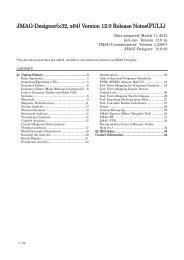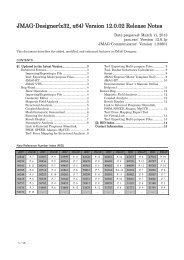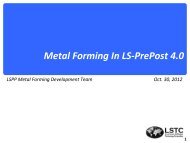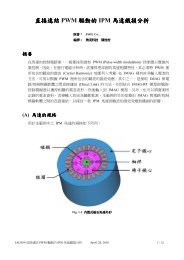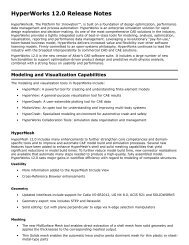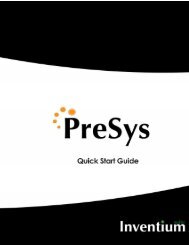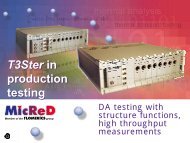LS-DYNA R7.0.0 (R7.79069) released Release notes for Version R7 ...
LS-DYNA R7.0.0 (R7.79069) released Release notes for Version R7 ...
LS-DYNA R7.0.0 (R7.79069) released Release notes for Version R7 ...
- No tags were found...
Create successful ePaper yourself
Turn your PDF publications into a flip-book with our unique Google optimized e-Paper software.
<strong>LS</strong>-<strong>DYNA</strong> <strong><strong>R7</strong>.0.0</strong> (<strong><strong>R7</strong>.79069</strong>) <strong>released</strong><br />
Filed under: release note<br />
New version of <strong>LS</strong>-<strong>DYNA</strong> is <strong>released</strong> <strong>for</strong> all common plat<strong>for</strong>ms.<br />
<strong>Release</strong> <strong>notes</strong> <strong>for</strong> <strong>Version</strong> <strong><strong>R7</strong>.0.0</strong><br />
Herein are summarized most of the new features, enhancements, and significant<br />
corrections made since the previous release, 971 R6.1.1. New features are listed<br />
first in no particular order. Enhancements and corrections are then listed by<br />
category.<br />
I. LICENSE<br />
• In the license file necessary to run <strong><strong>R7</strong>.0.0</strong>,<br />
1. the program names are <strong>LS</strong>-<strong>DYNA</strong> and MPP<strong>DYNA</strong>, and<br />
2. The OPTION is "REVISION 7".<br />
• Note that we have removed "971" from the program names.<br />
• For example, here's an excerpt from a <strong><strong>R7</strong>.0.0</strong> license file:<br />
<strong>LS</strong>-<strong>DYNA</strong> 12312013<br />
OPTION: REVISION 7<br />
MPP<strong>DYNA</strong> 12312013<br />
OPTION: REVISION 7<br />
II. DOCUMENTATION<br />
• The <strong><strong>R7</strong>.0.0</strong> Keyword User's Manual can be downloaded<br />
from www.lstc.com/download/manuals.<br />
III. NOTES<br />
• Three solvers (EM, CESE, and ICFD) which are new in this release. Please note that<br />
these solvers are currently only supported in a subset of the double precision, <strong><strong>R7</strong>.0.0</strong><br />
executables; please refer to<br />
http://ftp.lstc.com/user/ls-dyna/<strong><strong>R7</strong>.0.0</strong>/README_first (SMP) and<br />
http://ftp.lstc.com/user/mpp-dyna/<strong><strong>R7</strong>.0.0</strong>/README (MPP) <strong>for</strong> details.<br />
• A new volume mesher supporting the ICFD and CESE solvers.<br />
• Other new features, enhancements, and significant corrections not included in the<br />
previous <strong>LS</strong>-<strong>DYNA</strong> release, version 971 R6.1.1
.<br />
New <strong>R7</strong> Electromagnetic (EM) solver<br />
• Keyword family: *EM_<br />
• The keywords starting with *EM refer to and control the Electromagnetic solver<br />
problem set up<br />
• Solver Characteristics:<br />
• Implicit<br />
• Double precision<br />
• Dynamic memory handling<br />
• SMP and MPP<br />
• 2D axisymmetric solver / 3D solver<br />
• Automatic coupling with structural and thermal <strong>LS</strong>-<strong>DYNA</strong> solvers<br />
• FEM <strong>for</strong> conducting pieces only, no air mesh needed (FEM-BEM system)<br />
• Solid elements <strong>for</strong> conductors, shells can be insulators<br />
• Solver Main Features:<br />
• Eddy Current (a.k.a Induction-Diffusion) solver<br />
• Induced heating solver<br />
• Resistive heating solver<br />
• Imposed tension or current circuits<br />
• Exterior field<br />
• Magnetic materials (beta version)<br />
• Electromagnetic contact<br />
• EM Equation of states (Conductivity as a function of temperature)<br />
• Solver Applications (Non-exhaustive):<br />
• Electromagnetic <strong>for</strong>ming<br />
• Electromagnetic welding<br />
• Electromagnetic bending<br />
• Inductive heating<br />
• Resistive heating<br />
• Rail-gun
• Ring expansions<br />
.<br />
New <strong>R7</strong> Compressible CFD (CESE) solver<br />
• Keyword family: *CESE_<br />
• The keywords starting with *CESE refer to and control the Compressible CFD<br />
solver problem set up<br />
• Solver Characteristics:<br />
• Explicit<br />
• Double precision<br />
• Dynamic memory handling<br />
• SMP and MPP<br />
• 3D solver / special case 2D solver and 2D axisymmetric solver<br />
• Automatic coupling with structural and thermal <strong>LS</strong>-<strong>DYNA</strong> solvers<br />
• Eulerian fixed mesh or moving mesh (Either type input<br />
with *ELEMENT_SOLID cards or using *MESHcards)<br />
• Solver Main Features:<br />
• CESE method (Conservation Element / Solution Element) used <strong>for</strong> CFD solver<br />
• Highly accurate shock wave capturing<br />
• Cavitation model<br />
• Embedded (immersed) boundary approach or moving (fitting) approach <strong>for</strong> FSI<br />
problems<br />
• Coupled stochastic fuel spray solver (See *STOCHASTIC keywords)<br />
• Coupling with chemistry (See *CHEMISTRY keywords) solver<br />
• Solver Applications (Non-exhaustive) :<br />
• Shock wave capturing<br />
• Shock/acoustic wave interaction<br />
• Cavitating flows<br />
• Conjugate heat transfer problems<br />
• Many different kinds of stochastic particle flows, e.g, dust, water, fuel.<br />
• Chemically reacting flows, e.g, detonating flow, supersonic combustion.
.<br />
New <strong>R7</strong> Incompressible CFD (ICFD) solver<br />
• Keyword family: *ICFD_<br />
• The keywords starting with *ICFD refer to and control the incompressible CFD<br />
solver problem set up<br />
• Solver Characteristics:<br />
• Implicit<br />
• Double precision<br />
• Dynamic memory handling<br />
• SMP and MPP<br />
• 2D solver / 3D solver<br />
• Makes use of an automatic volume mesh generator <strong>for</strong> fluid domain<br />
(See *MESH keywords)<br />
• Coupling with structural and thermal <strong>LS</strong>-<strong>DYNA</strong> solvers<br />
• Solver Main Features:<br />
• Incompressible fluid solver<br />
• Thermal solver <strong>for</strong> fluids<br />
• Free Surface flows<br />
• Two-phase flows<br />
• Turbulence models<br />
• Transient or steady-state problems<br />
• Non-Newtonian fluids<br />
• Boussinesq model <strong>for</strong> convection<br />
• Loose or strong coupling <strong>for</strong> FSI (Fluid-structure interaction)<br />
• Exact boundary condition imposition <strong>for</strong> FSI problems<br />
• Solver Applications (Non-exhaustive) :<br />
• External aerodynamics <strong>for</strong> incompressible flows<br />
• Internal aerodynamics <strong>for</strong> incompressible flows<br />
• Sloshing, Slamming and Wave impacts<br />
• FSI problems
• Conjugate heat transfer problems<br />
.<br />
New <strong>R7</strong> Volume Mesh generator<br />
• Keyword family: *MESH_<br />
• The keywords starting with *MESH refer to and control the tools <strong>for</strong> the automatic<br />
volume mesh generator.<br />
• Mesh Generator Characteristics:<br />
• Automatic<br />
• Robust<br />
• Generic<br />
• Tetrahedral elements <strong>for</strong> 3D, Triangles in 2D<br />
• Closed body fitted mesh (surface mesh) needs to be provided <strong>for</strong> volume<br />
generation<br />
• Mesh Generator Main Features:<br />
• Automatic remeshing to keep acceptable mesh quality <strong>for</strong> FSI problems (ICFD<br />
only)<br />
• Adaptive meshing tools (ICFD only)<br />
• Anisotropic boundary layer mesh<br />
• Mesh element size control tools<br />
• Remeshing tools <strong>for</strong> surface meshes to ensure mesh quality<br />
• Mesh Generator Applications :<br />
• Used by the Incompressible CFD solver (ICFD).<br />
• Used by the Compressible CFD solver (CESE).<br />
.<br />
Airbag<br />
• Add new parameter VNTOPT to *AIRBAG_HYBRID, that allows user more control on<br />
bag venting area calculation.<br />
• Allow heat convection between environment and CPM bag (*AIRBAG_PARTICLE) bag.<br />
Apply proper probability density function to part's temperature created by the particle<br />
impact.
• *AIRBAG_PARTICLE + *SENSOR_SWITCH_SHELL_TO_VENT allows user to input<br />
load curve to control the venting using choking flow equation to get proper probability<br />
function <strong>for</strong> vents. There<strong>for</strong>e, this vent will have the same vent rate as real vent hole.<br />
• Add new option NP2P in *CONTROL_CPM to control the repartition frequency of CPM<br />
particles among processors. -- MPP only<br />
• Enhance *AIRBAG_PARTICLE to support a negative friction factor (FRIC or PFRIC) in<br />
particle to fabric contact. Particles are thus able to rebound at a trajectory closer to the<br />
fabric surface after contact.<br />
• Use heat convection coefficient HCONV and fabric thermal conductivity KP to get<br />
correct effective heat transfer coefficient <strong>for</strong> heat loss calculation in *AIRBAG_PARTICLE.<br />
(h_effective = 1/(1/H + shell_thickness/kP)) If KP is not given, H will be used as effective<br />
heat transfer coefficient.<br />
• Extend CPM inflator orifice limit from 100 to unlimited (*AIRBAG_PARTICLE).<br />
• Support dm_in_dt and dm_out_dt output to CPM chamber database<br />
(*DATABASE_ABSTAT) to allow user to study mass flow rate between multiple chambers.<br />
.<br />
Boundary<br />
• Previously, the number of ships (rigid bodies) in *BOUNDARY_MCOL, as specified by<br />
NMCOL, was limited to 2. Apparently, this was because the code had not been validated <strong>for</strong><br />
more than 2 rigid bodies, but it is believed that it should not be a problem to remove this<br />
restriction. Consequently, this limit has been raised to 10, with the caveat that the user<br />
should verify the results <strong>for</strong> NMCOL>2.<br />
• Implemented a structural-acoustic mapping scheme<br />
(*BOUNDARY_ACOUSTIC_MAPPING), <strong>for</strong> mapping transient structural nodal velocity to<br />
acoustic volume surface nodes. This is useful if the structure finite element mesh and the<br />
acoustic boundary/finite element mesh are mismatched.<br />
.<br />
Control<br />
• *ALE_REFINE has been replaced and expanded upon by<br />
the *CONTROL_REFINE family of commands. These commands invoke local mesh<br />
refinement of shells, solids, and ALE elements based on various criteria. Shells or solids in<br />
a region selected <strong>for</strong> refinement (parent element) are replaced by 4 shells or 8 solids,<br />
respectively.<br />
• *CONTROL_REFINE_SHELL applies to shells.
• *CONTROL_REFINE_SOLID applies to solids.<br />
• *CONTROL_REFINE_ALE and *CONTROL_REFINE_ALE2D applies to ALE<br />
elements.<br />
Each keyword has up to 3 lines of input. If only the 1st card is defined, the refinement<br />
occurs during the initialization. The 2nd card defines a criterion CRITRF to automatically<br />
refine the elements during the run. If the 3rd card is defined, the refinement can be reversed<br />
based on a criterion CRITM. All commands are implemented <strong>for</strong> MPP.<br />
• *CONTROL_REFINE_MPP_DISTRIBUTION distributes the elements required by the<br />
refinement across the MPP processes.<br />
• Fixed bug in *CONTROL_STAGED_CONSTRUCTION whereby staged construction<br />
was not working with the combination of Hughes-Liu beams and *CONTROL_ACCURACY.<br />
.<br />
Constrained<br />
• Added keyword *CONSTRAINED_MULTIPLE_GLOBAL <strong>for</strong> defining multi-node<br />
constraints <strong>for</strong> imposing periodic boundary conditions.<br />
• Enhancement <strong>for</strong> *CONSTRAINED_INTERPOLATION_SPOTWELD (SPR3):<br />
calculation of bending moment is more accurate now.<br />
• If *CONSTRAINED_NODAL_RIGID_BODY nodes are shared by several processors<br />
with mass scaling on, the added mass is not summed up across processors. This results in<br />
an instability of the NRB. -- MPP only<br />
.<br />
Contact<br />
• *CONTACT_FORMING_ONE_WAY_SURFACE_TO_SURACE_ORTHO_FRICTION c<br />
an now be defined by part set IDs when supplemented<br />
by *DEFINE_FRICTION_ORIENTATION. Segment sets with orientation<br />
per *DEFINE_FRICTION_ORIENTATION are generated automatically.<br />
• Contact <strong>for</strong>ce of *CONTACT_ENTITY is now available in int<strong>for</strong><br />
(*DATABASE_BINARY_INTFOR).<br />
• Fix <strong>for</strong> *CONTACT_AUTOMATIC_..._TIEBREAK options 9 and 11: element size<br />
dependent failure stresses (NF<strong>LS</strong>/SF<strong>LS</strong>
• *CONTACT_FORCE_TRANSDUCER_PENALTY will now accept node sets <strong>for</strong> both the<br />
slave and master sides, which should allow them to work correctly <strong>for</strong> eroding materials.<br />
BOTH sides should use node sets, or neither.<br />
• Added option to create a backup penalty-based contact <strong>for</strong> a tied constraint-based<br />
contact in the input (IPBACK on Card E of *CONTACT).<br />
• New option <strong>for</strong> *CONTACT_ENTITY. If variable SO is set to 2, then a constraint-like<br />
option is used to compute the <strong>for</strong>ces in the normal direction. Friction is treated in the usual<br />
way.<br />
• *CONTACT_ENTITY: allow friction coefficient to be given by a "coefficient vs time" load<br />
curve (input < 0 -> absolute value is the load curve ID). Also, if the friction coefficient >= 1.0,<br />
the node sticks with no sliding at all.<br />
• Fix <strong>for</strong> MPP implementation of *CONTACT_ORTHO_FRICTION.<br />
• Minor tweak to the way both MPP and SMP handle nodes sliding off the ends of beams<br />
in*CONTACT_GUIDED_CABLE.<br />
• Fix MPP groupable tied *CONTACT energy calculations. The contact was working<br />
correctly, but the energy calculation was incorrect since the changes of r71470.<br />
• Frictional energy output in sleout (*DATABASE_SLEOUT) supported<br />
<strong>for</strong> *CONTACT_..._MORTAR.<br />
• Tiebreak damage parameter output as "contact gap" in int<strong>for</strong> file<br />
<strong>for</strong>*CONTACT_AUTOMATIC_SURFACE_TO_SURFACE_TIEBREAK_MORTAR,<br />
OPTION=9.<br />
• Added MPP support<br />
<strong>for</strong> *CONTACT_2D_AUTOMATIC_SINGLE_SURFACE and*CONTACT_2D_AUTOMATIC<br />
_SURFACE_TO_SURFACE.<br />
.<br />
Database<br />
• Eliminate automatic writing of a d3plot plot state after each 3D tetrahedral remeshing<br />
operation (*CONTROL_REMESHING) to reduce volume of output.<br />
• Generate disbout output (*DATABASE_DISBOUT) <strong>for</strong> MPP and SMP binout files.<br />
• Extend *DATABASE_MASSOUT to include option to output mass in<strong>for</strong>mation on rigid<br />
body nodes.<br />
• Bug fixes <strong>for</strong> D3PLOT:<br />
• Fixed bug in title of d3plot <strong>for</strong> double precision and <strong>LS</strong>TC_BINARY=ieee32<br />
<strong>for</strong>mat.
• Fixed bug in d3plot if a solid part is removed.<br />
• Fixed bug in d3plot if any part is removed <strong>for</strong> 10-noded tetrahedral element<br />
• Fixed bug where hiding a part from d3plot removed its effect from the model. A<br />
removed part was also removed from contact definition.<br />
• Fixed bug in binary file output (d3plot, d3drlf, ...) if the size of first (geometry) file<br />
is bigger than the defined size.<br />
• Fixed improper warning message if any part is removed from d3plot.<br />
• Added new keyword *CHANGE_OUTPUT <strong>for</strong> full deck restart to override default<br />
behavior of overwriting existing ASCII files. For small restart, this option has no effect since<br />
all ASCII output is appended to the result of previous run already.<br />
• Added new option (NEWLENGD) to 2nd field of 3rd card of *CONTROL_OUTPUT. to<br />
write more detailed legend in ASCII output files. At present, only rc<strong>for</strong>c and jnt<strong>for</strong>c are<br />
implemented.<br />
• Fixed bug in writing dyna.inc (*INCLUDE_TRANSFORM)<br />
<strong>for</strong> *ELEMENT_DISCRETE,*ELEMENT_SOLID, and *ELEMENT_TSHELL.<br />
• Fixed bug in d3part files (*DATABASE_BINARY_D3PART) triggered<br />
by *MAT_ADD_EROSION (SMP only).<br />
• Fixed bug in d3part output triggered by MAXINT
• Support <strong>LS</strong>DA/binout output <strong>for</strong> new pllyout file<br />
(*DATABASE_PLLYOUT, *ELEMENT_BEAM_PULLEY) in both SMP and MPP.<br />
.<br />
Element<br />
• Allow degenerated hexahedrons (pentas) <strong>for</strong> cohesive solid elements (ELFORM=19, 20)<br />
that evolve from an extrusion of triangular shells. The input of nodes on the element cards<br />
<strong>for</strong> such a pentahedron is given by: N1,N2,N3,N3,N4,N5,N6,N6<br />
• Fixed error in reading *ELEMENT_SHELL_COMPOSITE.<br />
• Fixed bug in *SECTION_SHELL <strong>for</strong> seatbelt where SECID was input as a label.<br />
• Add new option to activate drilling constraint <strong>for</strong>ce <strong>for</strong> shells in explicit calculations. This<br />
can be defined by parameters DRCPSID (part set) and DRCPRM (scaling factor)<br />
on *CONTROL_SHELL.<br />
• Add SMP ASCII database "pllyout" (*DATABASE_PLLYOUT)<br />
<strong>for</strong> *ELEMENT_BEAM_PULLEY.<br />
.<br />
FREQUENCY_DOMAIN<br />
• *FREQUENCY_DOMAIN_ACOUSTIC_BEM:<br />
• Added an option to output real part of acoustic pressure in time domain.<br />
• Enabled BEM acoustic computation following implicit transient analysis.<br />
• Implemented coupling between steady state dynamics and collocation acoustic<br />
BEM.<br />
• Implemented Acoustic Transfer Vector (ATV) to variational indirect BEM<br />
acoustics.<br />
• Enabled boundary acoustic mapping in BEM acoustics.<br />
• *FREQUENCY_DOMAIN_ACOUSTIC_FEM:<br />
• Added boundary nodal velocity to binary plot file d3acs.<br />
• Implemented pentahedron elements in FEM acoustics.<br />
• Enabled using boundary acoustic mapping in FEM acoustics.<br />
• *FREQUENCY_DOMAIN_FRF:<br />
• Updated FRF to include output in all directions (VAD2=4).<br />
• Added treatment <strong>for</strong> FRF with base acceleration (node id can be 0).
• *FREQUENCY_DOMAIN_RANDOM_VIBRATION:<br />
• Updated calculating PSD and RMS von Mises stress in random vibration<br />
environment, based on the Report of Sandia National Laboratories, 1998.<br />
• *FREQUENCY_DOMAIN_RANDOM_VIBRATION_FATIGUE:<br />
• Implemented an option to incorporate initial damage ratio in random vibration<br />
fatigue.<br />
• *FREQUENCY_DOMAIN_RESPONSE_SPECTRUM:<br />
• Implemented double sum methods (based on Gupta-Cordero coefficient,<br />
modified Gupta-Cordero coefficient, and Rosenblueth-Elorduy coefficient).<br />
• Updated calculating von Mises stress in response spectrum analysis.<br />
• Implemented treatment <strong>for</strong> multi simultaneous input spectra.<br />
• Improved double sum methods by reducing number of loops.<br />
• *FREQUENCY_DOMAIN_SSD:<br />
• Added the option to output real and imaginary parts of frequency response to<br />
d3ssd.<br />
• Added the option to output relative displacement, velocity and acceleration in<br />
SSD computation in the case of base acceleration. Previously only absolute values were<br />
provided.<br />
• Implemented keyword *FREQUENCY_DOMAIN_MODE_{OPTION} so that user can<br />
select the vibration modes to be used <strong>for</strong> frequency response analysis.<br />
• Implemented keyword *SET_MODE_{OPTION} so that user can define a set of vibration<br />
modes, to be used <strong>for</strong> frequency response analysis.<br />
• Implemented keyword *FREQUENCY_DOMAIN_PATH to define the path of binary<br />
databases containing mode in<strong>for</strong>mation, used in restarting frequency domain analysis, e.g.<br />
frf, ssd, random vibration.<br />
.<br />
INITIAL<br />
• Compute normal component of impulse <strong>for</strong> oblique plates in *INITIAL_MINE_IMPU<strong>LS</strong>E.<br />
The feature is no longer limited to horizontal plates.<br />
• Disable license security <strong>for</strong> *INITIAL_IMPU<strong>LS</strong>E_MINE. The feature is no longer<br />
restricted.<br />
• Fix a bug of *INITIAL_STRESS_SOLID <strong>for</strong> 4-noded tetrahedral elements.
• Enabled hourglass type 7 to work well<br />
with *INITIAL_FOAM_REFERENCE_GEOMETRY so that initial hourglass energy is<br />
properly calculated and foam will spring back to the initial geometry.<br />
.<br />
Load<br />
• Accommodate erosion of thin shells in *LOAD_BLAST_ENHANCHED.<br />
• *LOAD_VOLUME_LOSS has been changed such that after the analysis time exceeds<br />
the last point on the curve of volume change fraction versus time, the volume change is no<br />
longer en<strong>for</strong>ced.<br />
• *LOAD_BODY_POROUS new option AOPT added to assign porosity values in material<br />
coordinate system.<br />
• Added *LOAD_SEGMENT_FILE.<br />
.<br />
Sensor<br />
• Add new sensor definition, *SENSOR_DEFINE_ANGLE. This card traces the angle<br />
<strong>for</strong>med between two lines.<br />
• *SENSOR_DEFINE_NODE can be used to trace the magnitude of nodal values<br />
(coordinate, velocity or accleration) when VID is "0" or undefined.<br />
• Add two new parameters to *SENSOR_DEFINE_ELEMENT, scale factor and power, so<br />
that user can adjust the element-based sensor values (strain, stress, <strong>for</strong>ce...)<br />
.<br />
Material<br />
• Change history variables 10-12<br />
in *MAT_054/*MAT_ENHANCED_COMPOSITE_DAMAGE (thin shells only) to represent<br />
strains in material coordinate system rather than in local element coordinate system. This is<br />
a lot more helpful <strong>for</strong> postprocessing issues. This change should not lead to different results<br />
other than due to different round-off errors.<br />
• New features and enhancements to *MAT_244/*MAT_UHS_STEEL:<br />
• Added implicit support <strong>for</strong> *MAT_244.<br />
• Changed the influence of the austenite grain size in *MAT_244 according to Li et<br />
al.<br />
• Changed the start temperatures to fully follow WATT et al and Li et al.
• Hardness calculation is now improved when noncontinuous cooling is applied.<br />
i.e., tempering.<br />
• Added temperature dependent Poisson ratio and advanced reaction kinetics.<br />
• Added new advanced option to describe the thermal expansion coefficients <strong>for</strong><br />
each phase.<br />
• Added option to use Curve ID or a Table ID <strong>for</strong> describing the latent heat<br />
generation during phase transormations.<br />
• Added support <strong>for</strong> table definition <strong>for</strong> Youngs modulus. Now you can have one<br />
temperature dependent curve <strong>for</strong> each of the 5 phases<br />
• Bugfixes to *MAT_244:<br />
• Fixed a bug related to thick shell <strong>for</strong>mulation 1.<br />
• Fixed an error in load curves when using temperature dependent variables<br />
(Youngs modulus and poissons ratio).<br />
• Fixed a problem when using dynain files.<br />
• Added support <strong>for</strong> implicit to *MAT_188.<br />
• Added material<br />
model *MAT_273/*MAT_CDPM/*MAT_CONCRETE_DAMAGE_PLASTIC_MODEL. This<br />
model is aimed at simulations where failure of concrete structures subjected to dynamic<br />
loadings is sought. The model is based on effective stress plasticity and has a damage<br />
model based on both plastic and elastic strain measures. Implemented <strong>for</strong> solids only but<br />
both <strong>for</strong> explicit and implicit simulations. Using an implicit solution when damage is activated<br />
may trigger a slow convergense. IMFLAG = 4 or 5 can be useful.<br />
• Added an option in *MAT_266 (*MAT_TISSUE_DISPERSED) so that the user can tailor<br />
the active contribution with a time dependent load curve instead of using the internal<br />
hardcoded option. See ACT10 in the User's Manual.<br />
• Fixed a problem related to the shell thickness update (ISTUPD in *CONTROL_SHELL)<br />
and *MAT_255.<br />
• *MAT_173/*MAT_MOHR_COULOMB is available in 2D.<br />
• Fix a bug affecting evolution type failure, IDAM of *MAT_ADD_EROSION
• Enable *MAT_103 and *MAT_104 to discretize the material load curves according to the<br />
number of points specified by LCINT in *CONTROL_SOLUTION.<br />
• Implement Prony series up to 18 terms <strong>for</strong> shells<br />
using *MAT_076/*MAT_GENERAL_VISCOELASTIC.<br />
• Added *DEFINE_STOCHASTIC_VARIATION and the STOCHASTIC option<br />
<strong>for</strong> *MAT_010, *MAT_015,*MAT_024, *MAT_081, *MAT_098 <strong>for</strong> shells, solids, and type 13<br />
tets. This feature defines a stochastic variation in the yield stress and damage/failure of the<br />
a<strong>for</strong>ementioned material models.<br />
• Minor modification <strong>for</strong> *DEFINE_CONNECTION_PROPERTIES:<br />
• PROPRUL=2: thinner weld partner is first partner,<br />
• PROPRUL=3: bottom (nodes 1-2-3-4) weld partner is first partner.<br />
• Add spotweld area to debug output of *DEFINE_CONNECTION_PROPERTIES which<br />
is activated by*CONTROL_DEBUG.<br />
• Add support of *MAT_ADD_EROSION option NUMFIP
• Fix <strong>for</strong> *MAT_119 with initial displacements IUR, IUS, IUT, IWR, IWS, IWT which were<br />
erroneously applied twice.<br />
• Fix <strong>for</strong> *MAT_083 with damage/hysteresis (TBID0). Combination with<br />
FMATRX=2 on*CONTROL_SOLID (default in implicit) could lead to uninitialized energies<br />
and consequential incorrect unloading behavior.<br />
• Fix <strong>for</strong> *MAT_104. For FLAG = -1 (anisotropic damage), it was possible that the load<br />
curve number of LCSS was changed internally.<br />
• Fix <strong>for</strong> combination of *INCLUDE_TRANSFORM with FCTTIM.ne.1.0 and material<br />
tables with logarithmic strain rates. The trans<strong>for</strong>mation of these logarithmic strain rates is<br />
correct now.<br />
• Add a new feature to *MAT_125 allowing C1 and C2 to be used in calculation of back<br />
stress. When plastic strain < 0.5%, C1 is used, otherwise C2 is used as described in<br />
Yoshida's paper.<br />
• Extend non-linear strain path (_NLP_FAILURE) in *MAT_037 to implicit.<br />
• *MAT_173/*MAT_MOHR_COULOMB now works in ALE. A new option has been added<br />
to suppress the tensile limit on hydrostatic stress - recommended <strong>for</strong> ALE multi-material<br />
use.<br />
• Upgraded *MAT_172/*MAT_CONCRETE_EC2.<br />
• Corrections to DEGRAD option.<br />
• Fix bug affecting shells (not beams). When an element has two cracks, and one<br />
crack is under compression while the other is still widening, the element could<br />
erroneously shrink in the compression direction. Another symptom of the same bug<br />
would be that if two cracks are opening at the same time in the same element, one or<br />
both might not follow the expected stress-crack opening curve.<br />
• Concrete and rein<strong>for</strong>cement types 7 and 8 have been added to reflect changes to<br />
Eurocode 2.<br />
• Extra history variables <strong>for</strong> rein<strong>for</strong>cement stress and strain are now output as zero<br />
<strong>for</strong> zero-fraction rein<strong>for</strong>cement directions.<br />
• Added RCDC model <strong>for</strong> solid *MAT_082.<br />
• Added Feng's failure model to solid *MAT_021.<br />
• Added *MAT_027 <strong>for</strong> beams.<br />
• Added *DEFINE_HAZ_PROPERTIES and *DEFINE_TAILOR_WELDED_BLANK <strong>for</strong><br />
modifying material behavior near a spot weld.<br />
• Added fourth rate <strong>for</strong>m to viscoplastic Johnson-Cook model (*MAT_015).
• Added option to *MAT_224 to not delete the element if NUMINT=-200.<br />
• New damage initiation option 3 in multi fold damage criteria in *MAT_ADD_EROSION.<br />
Very similar to option 2 but insensitive to pressure.<br />
• Rotational resistance in *MAT_034/*MAT_FABRIC. Optionally the user may specify the<br />
stiffness, yield and thickness of and elastic-perfectly-plastic coated layer of a fabric that<br />
results in a rotational resistance during the simulation.<br />
• FLDNIPF
• When unload/reload curves with negative curve ID are input (curve stretch<br />
options), the code that finds the intersection point now extrapolates the curves at their<br />
end rather than simply printing an error message if an intersection point cannot be found<br />
be<strong>for</strong>e the last point in either curve.<br />
• Fix bug in output of crack data <strong>for</strong> *MAT_084. -- MPP only<br />
.<br />
ALE<br />
• Map 1D to 3D by beam-volume averaging the 1D data over the 3D elements<br />
(*INITIAL_ALE_MAPPING).<br />
• In a 3D to 3D mapping (*INITIAL_ALE_MAPPING), map the relative displacements <strong>for</strong><br />
the penalty coupling in *CONSTRAINED_LAGRANGE_IN_SOLID<br />
• The .xy files associated with *DATABASE_ALE_MAT are now created when sense<br />
switches sw1, sw2, quit, or stop are issued.<br />
• *ALE_ESSENTIAL_BOUNDARY is available in 2D.<br />
• *DATABASE_FSI is available <strong>for</strong> 2D (MPP).<br />
• *ALE_ESSENTIAL_BOUNDARY implemented to apply slip-only velocity BC along ALE<br />
mesh surface.<br />
• *CONTROL_ALE flag INIJWL=2 option added to balance initial pressure state between<br />
ALE Soil and HE.<br />
.<br />
SPH<br />
• Include SPH element (*ELEMENT_SPH) in time step report.<br />
• Time step and internal energy of 2D axisymmetric SPH elements are calculated in a<br />
new way more consistent with the viscosity <strong>for</strong>ce calculation.<br />
• Only apply viscosity <strong>for</strong>ce to x and y components of 2D axisymmetric SPH element, not<br />
on hoop component.<br />
• MAXV in *CONTROL_SPH can be defined as a negative number to turn off velocity<br />
checking.<br />
• Improve calculation of 2D axisymmetric SPH contact <strong>for</strong>ce<br />
in *DEFINE_SPH_TO_SPH_COUPLING.<br />
• Added the following material models <strong>for</strong> SPH particles:<br />
• *MAT_004/*MAT_ELASTIC_PLASTIC_THERMAL (3D only)
• *MAT_106/*MAT_ELASTIC_VISCOPLASTIC_THERMAL<br />
• Added a new parameter DFACT <strong>for</strong> *DEFINE_SPH_TO_SPH_COUPLING. DFACT<br />
invokes a viscous term to damp the coupling between two SPH parts and thereby reduce<br />
the relative velocity between the parts.<br />
• Added *BOUNDARY_CONVECTION and *BOUNDARY_RADIATION <strong>for</strong> explicit SPH<br />
thermal solver.<br />
• Fix bug <strong>for</strong> SPH symmetric boundary conditions (*CONTROL_SPH).<br />
.<br />
EFG<br />
• *CONTROL_REMESHING_EFG:<br />
• Add eroding failed surface elements and reconstructing surface in EFG<br />
adaptivity.<br />
• Add a control parameter <strong>for</strong> monotonic mesh resizing in EFG adaptivity.<br />
• Add searching and correcting self-penetration <strong>for</strong> adaptive parts in 3D<br />
tetrahedron remeshing.<br />
• Enhance 3D axisymmetric remeshing with 6-node/8-node elements<br />
(*CONTROL_REMESHING):<br />
• Use RMIN/RMAX along with SEGANG to determine element size.<br />
• Remove the restriction that the reference point of computational model has to be<br />
at original point (0,0,0).<br />
• Rewrite the searching algorithm <strong>for</strong> identifying the feature lines of cross-sections<br />
in order to provide more stable remeshing results.<br />
• Improve rigid body motion in EFG shell type 41.<br />
• Support EFG pressure smoothing in EFG solid type 42<br />
<strong>for</strong> *MAT_ELASTIC_VISCOPLASTIC_THERMAL.<br />
• Add visco effect <strong>for</strong> implicit EFG solid type 42<br />
• Add new EFG solid type 43 (called Meshfree-Enriched FEM, MEFEM) <strong>for</strong> both implicit<br />
and explicit. This element <strong>for</strong>mulation is able to relieve the volumetric locking <strong>for</strong><br />
nearly-incompressible material (eg. rubber) and per<strong>for</strong>ms strain smoothing across elements<br />
with common faces.<br />
• EFG shell adaptivity no longer requires a special license.<br />
• Application of EFG in an implicit analysis no longer requires a special license.
.<br />
Implicit<br />
• Fix sign <strong>for</strong> resultant moments <strong>for</strong> joints using implicit (jnt<strong>for</strong>c).<br />
• Fix numerous problems with stress recovery <strong>for</strong> mode shapes especially <strong>for</strong> intermittent<br />
eigenvalue analysis.<br />
• Fix output of <strong>for</strong>ces pertaining to prescribed motion (bndout) <strong>for</strong> implicit.<br />
• Fix *INTERFACE_LINKING problem <strong>for</strong> SMP implicit.<br />
• Fix implicit output of spc<strong>for</strong>c <strong>for</strong> *CONSTRAINED_COORDINATE.<br />
• Fix implicit *BOUNDARY_SPC with birth time and death time.<br />
• Add *SENSOR_CONTROL <strong>for</strong> prescribed motion constraints in implicit.<br />
• Update *INTERFACE_LINKING_NODE in implicit to catch up with explicit, including<br />
adding scaling factors.<br />
• Add support <strong>for</strong> *DATABASE_RCFORC_MOMENT <strong>for</strong> implicit.<br />
• Enhance Iterative solvers <strong>for</strong> Implicit Mechanics.<br />
• Add, after the first implicit time step, the output of projected cpu and wall clock times.<br />
This was already in place <strong>for</strong> explicit. Also echo the termination time.<br />
• Fix an issue with implicit storing the resultant <strong>for</strong>ces <strong>for</strong> *CONSTRAINED_SPOTWELD.<br />
.<br />
Thermal<br />
• Add variable MXDMP in *CONTROL_THERMAL_SOLVER to write thermal<br />
conductance matrix and right-hand side every MXDMP time steps.<br />
• Add keyword *CONTROL_THERMAL_EIGENVALUE to calculate eigenvalue(s) of each<br />
thermal conductance matrix.<br />
• New thermal material keyword --> *MAT_THERMAL_ORTHOTROPIC_TD_LC This is<br />
an orthtropic material with temperature dependent properties defined by load curves.<br />
• Change in structured file <strong>for</strong>mat <strong>for</strong> control card 27 (first thermal control card). Several<br />
input variables used i5 <strong>for</strong>mat limiting their value to 99,999. A recent large model exceeded<br />
this limit. The <strong>for</strong>mat was changed to i10. This change is not backward compatible. Old<br />
structured input files will no longer run unless control card 27 is changed to the new i10<br />
<strong>for</strong>mat. This change does not affect the KEYWORD file.<br />
• Fix coupled thermal solution <strong>for</strong> problems using thick thermal shells.
• Fix computation of assembled stiffness matrix <strong>for</strong> the unsymmetric case. Should only<br />
affect coupled thermal/implicit mechanical problems in MPP.<br />
• Thermal material *MAT_T07/*MAT_THERMAL_CWM <strong>for</strong> welding simulations to be<br />
used in conjunction with *MAT_270/*MAT_CWM mechanical counterpart.<br />
.<br />
MPP<br />
• Modify decomposition costs of *MAT_181 and *MAT_183.<br />
• Fix transfer of mes* files at code termination.<br />
• Fix <strong>for</strong> possible problem in *CONTROL_MPP_DECOMPOSTION_ARRANGE_PARTS.<br />
• Fix <strong>for</strong> MPP *CONTACT_GUIDED_CABLE in case some processor has no slave nodes.<br />
• Fixes to MPP reporting of element controlling the time step.<br />
• Introduction of new timing routines and summary at termination.<br />
• Echo "MPP contact is groupable" flag to d3hsp<br />
• For MPP groupable tied contact only: output of part IDs <strong>for</strong> MAT_100_DA spotwelds<br />
(*DEFINE_CONNECTION_PROPERTIES) was missing.<br />
• Bodies using *MAT_RIGID_DISCRETE were never expected to share nodes with<br />
non-rigid bodies, but this now works in MPP.<br />
• Fix variable initialization that resulted in MPP writing bad int<strong>for</strong> data<br />
(*DATABASE_BINARY_INTFOR) on some systems.<br />
• There is no longer any built-in limitation on the number of processors that may be used<br />
in MPP.<br />
• Echo contents of the MPP pfile (including keyword additions) to the d3hsp and mes0000<br />
files.<br />
• Add new keyword *CONTROL_MPP_PFILE, which allows <strong>for</strong> insertion of text following<br />
this command to be inserted into the MPP pfile (p=pfile).<br />
• Change in MPP treatment of *CONSTRAINED_TIE-BREAK. They now share a single<br />
MPI communicator, and a single round of communication. This should improve per<strong>for</strong>mance<br />
<strong>for</strong> problems with large numbers of these, without affecting the results.<br />
• Fix MPP decomposition error <strong>for</strong> *LOAD_BODY_GENERALIZED that could result in<br />
these <strong>for</strong>ces being applied incorrectly in some cases.<br />
• Fix summation order <strong>for</strong> *CONSTRAINED_LAGRANGE_IN_SOLID, CTYPE=2 <strong>for</strong> rebar.<br />
This will avoid the round off error causing slightly different shared nodal velocity on echo<br />
processor. -- MPP only
.<br />
Forming<br />
• Added two input variables <strong>for</strong> *CONTROL_FORMING_ONESTEP simulation:<br />
• TSCLMIN is a scale factor limiting the thickness reduction.<br />
• EPSMAX defines the maximum plastic strain allowed.<br />
• Added output of strain and stress tensors <strong>for</strong> onestep<br />
solver *CONTROL_FORMING_ONESTEP, to allow better evaluation of <strong>for</strong>mability.<br />
• Improved *CONTACT_AUTO_MOVE. Be<strong>for</strong>e: Changes the termination time, and it<br />
causes problems when several tools need to be moved. Now: Does not change the<br />
termination time, but changes the current time. In this way, several tools can be moved<br />
without the need to worry about the other tool's move. This is especially useful in<br />
multi-flanging and hemming simulations.<br />
• Made improvements to previously undocumented keyword *INTERFACE_BLANKSIZE,<br />
including adding the options _INITIAL_TRIM, and _INITIAL_ADAPTIVE. This keyword was<br />
developed <strong>for</strong> blank size development in sheet metal <strong>for</strong>ming. Generally, <strong>for</strong> a single<br />
<strong>for</strong>ming process, only the option _DEVELOPMENT is needed, and inputs are an initial<br />
estimated blank shape, a <strong>for</strong>med blank shape, and a target blank shape in either mesh or<br />
boundary coordinates. Output will be the calculated/corrected initial blank shape. Initial<br />
blank mesh and <strong>for</strong>med blank mesh can be different (e.g. adaptive). For a multi-stamping<br />
process involving draw, trimming and flanging, all three options are needed. Related<br />
commands <strong>for</strong> blank size estimation are *CONTROL_ FORMING_ONESTEP, and <strong>for</strong> trim<br />
line development,*CONTROL_FORMING_UNFLANGING.<br />
• Made improvements and added features to previously undocumented<br />
keyword*CONTROL_FORMING_UNFLANGING. This keyword unfolds flanges of a<br />
de<strong>for</strong>mable blank, e.g., flanged or hemmed portions of a sheet metal part, onto a rigid<br />
tooling mesh using the implicit static solver. using the implicit static solver. It is typically<br />
used in trim line mapping during a draw die development process. The 'roots' of the<br />
flanges or hemmed edges are automatically processed based on a user input of a distance<br />
tolerance between the flanges/hemmed edges and rigid tool. It includes the ability to handle<br />
a vertical flange wall. Other keywords related to blank size development<br />
are,*CONTROL_FORMING_ONESTEP,<br />
and *INTERFACE_BLANKSIZE_DEVELOPMENT.<br />
• Added keyword *CONTROL_FORMING_OUTPUT which allows control of d3plot output<br />
by specifying distances to tooling home. It works with automatic position of stamping tools<br />
using*CONTROL_FORMING_AUTOPOSITION_PARAMETER.
• Added the LOCAL_SMOOTH option to *INTERFACE_COMPENSATION_NEW which<br />
features smoothing of a tool's local area mesh, which could otherwise become distorted due<br />
to, e.g.,<br />
• bad/coarse mesh of the original tool surface,<br />
• tooling pairs (<strong>for</strong> example, flanging post and flanging steel) do not maintain a<br />
constant gap,<br />
• several compensation iterations.<br />
• This new option also allows <strong>for</strong> multiple regions to be smoothed. Local areas are<br />
defined by*SET_LIST_NODE_SMOOTH.<br />
.<br />
Discrete Element Method<br />
• Added output to rc<strong>for</strong>c <strong>for</strong> *DEFINE_DE_TO_SURFACE_COUPLING.<br />
• Implement traction surface <strong>for</strong> *DEFINE_DE_TO_SURFACE_COUPLING.<br />
• Add keyword *DATABASE_BINARY_DEMFOR with command line option<br />
dem=dem_int_<strong>for</strong>ce. This will turn on the DEM interface <strong>for</strong>ce file <strong>for</strong> DEM coupling option.<br />
The output frequency is controlled by the new keyword.<br />
• Add new feature *DEFINE_DE_INJECTION to allow DEM particle dropping from user<br />
defined plane.<br />
• Add new option _VOLUME to *ELEMENT_DISCRETE_SPHERE. This will allow DEM<br />
input based on per unit density and use *MAT card to get consistent material properties.<br />
.<br />
Isogeometric Elements<br />
• Added FORM=-4 <strong>for</strong> *ELEMENT_SHELL_NURBS_PATCH. Rotational dofs are<br />
automatically set at control points at the patch boundaries, whereas in the interior of the<br />
patch only translational dofs are present. This helps <strong>for</strong> joining multiple nurbs patches at<br />
their C0-boundaries.<br />
• Disabled FORM=2 and 3 <strong>for</strong> *ELEMENT_SHELL_NURBS_PATCH. These <strong>for</strong>mulations<br />
are experimental and not fully validated yet.<br />
• Added energy computation <strong>for</strong> isogeometric shells<br />
(*ELEMENT_SHELL_NURBS_PATCH) to matsum.<br />
• Allow isogeometric shells (*ELEMENT_SHELL_NURBS_PATCH) to behave as rigid<br />
body (*MAT_RIGID).
• Fix <strong>for</strong> degenerated isogeometric shells (*ELEMENT_SHELL_NURBS_PATCH) that<br />
share multiple control-points at the same physical location, which results in a not well<br />
defined element normal. This caused stability problems and error terminations.<br />
.<br />
Miscellaneous<br />
• Fix a bug affecting *INCLUDE_TRANSFORM that refers to a trans<strong>for</strong>mation<br />
(*DEFINE_TRANSFORMATION) involving SCALE.<br />
• Added "g" as abbreviation <strong>for</strong> gigawords in specification of memory on execution line,<br />
e.g, memory=16g is 16 billion words.<br />
• Suppress non-printing characters in *COMMENT output.<br />
• Add command line option "pgpkey" to output the current public PGP key used by<br />
<strong>LS</strong>-<strong>DYNA</strong>. The output goes to the screen as well as a file named "lstc_pgpkey.asc"<br />
suitable <strong>for</strong> directly importing into GPG.<br />
• When reading the NAMES file, allow a '+' anywhere on a line to indicate there will be a<br />
following line, not just at the end. This was never intended, but worked be<strong>for</strong>e r73972 and<br />
some customers use it that way.<br />
• Check <strong>for</strong> integer overflow when processing command line arguments and the memory<br />
value on the*KEYWORD card.<br />
• Added new capability <strong>for</strong> *INTERFACE_LINKING_NODE to scale the displacements of<br />
the moving interface.<br />
• Several fixes <strong>for</strong> internal CASE driver.<br />
• Fix problem of <strong>LS</strong>DA file names getting mangled in the restart file which was causing file<br />
reopening problems during restarts.<br />
• Support <strong>for</strong> *KEYWORD_JOBID with internal *CASE driver.<br />
• *DAMPING_FREQUENCY_RANGE now works <strong>for</strong> implicit dynamic solutions. An error<br />
check has been added to ensure that the timestep is small enough <strong>for</strong> the damping card to<br />
work correctly.<br />
• Added new option *DAMPING_FREQUENCY_RANGE_DEFORM to damp only the<br />
de<strong>for</strong>mation instead of the global motion.<br />
• Fixed bug affecting models containing<br />
both *DAMPING_GLOBAL and*DAMPING_FREQUENCY_RANGE. This combination is<br />
not recommended (and generates a warning message) but such models could previously<br />
generate unpredictable error messages.<br />
• Added *DEFINE_VECTOR_NODES. A vector is defined using two node IDs.
• Add sense switch "prof" to output current timing profile to messag (SMP) file or mes####<br />
(MPP) files. Also, <strong>for</strong> MPP only, collect timing in<strong>for</strong>mation from processor and output to<br />
prof.out when sense switch "prof" is detected.



